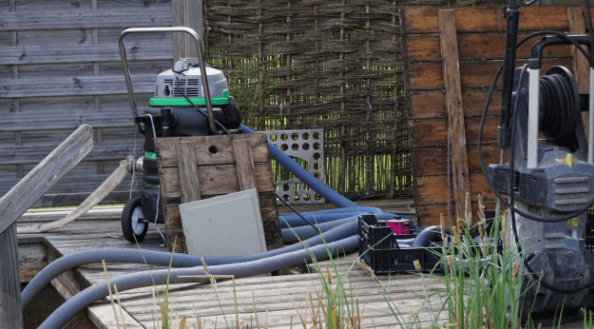Expert Tips for Using a Swimming Pond Vacuum for Natural Pond Cleaning

A natural swimming pond is a beautiful addition to any garden, offering clear water, a refreshing swim, and a peaceful, eco-friendly environment. But like any water feature, it needs proper cleaning to stay healthy and inviting. One of the most effective tools for this job is a swimming pond vacuum. When used the right way, a swimming pond vacuum helps remove sludge, dirt, and debris without disrupting the natural balance of your pond. This guide shares expert tips that make cleaning easier, faster, and more efficient so you enjoy fresh, clear water all season long.
Why a Swimming Pond Vacuum Is Essential for Natural Cleaning
A swimming pond vacuum plays an important role in natural pond care. It removes buildup at the bottom, such as leaves, algae, sand, and sludge, which can make the water dirty and affect the pond’s ecosystem. Natural ponds rely on biological balance, and too much waste can harm plants, reduce oxygen, and affect water clarity. A swimming pond vacuum keeps the water clean without the need for chemical treatments, helping your pond remain safe for swimming and healthy for plants and wildlife.
Cleaning Without Disturbing the Pond’s Natural Balance
Unlike harsh cleaning methods that disrupt water organisms, a swimming pond vacuum cleans gently. It targets debris and dirt while keeping beneficial bacteria, plants, and natural pond life intact. This makes it the perfect tool for anyone who wants a pond that stays natural but still looks fresh and clear.
Choose the Right Swimming Pond Vacuum for Best Results
Not all vacuums are the same, and the right model makes cleaning easier. Selecting the right vacuum depends on pond size, depth, and cleaning needs.
Key Features to Look For When Buying a Swimming Pond Vacuum
Here are the most important features experts recommend:
- Strong suction power for sludge removal
- Multiple nozzles for different surfaces
- A long hose for deep or large ponds
- Auto-drain or continuous suction to save time
- Wheels or lightweight design for easy movement
A vacuum designed specifically for natural or swimming ponds works better than a standard water vacuum.
Manual vs Automatic: Which One Is Better?
Manual vacuums are ideal for small to medium ponds and offer better control. Automatic vacuums are great for larger ponds because they reduce physical effort and complete cleaning faster. Choosing the right type makes your cleaning routine more efficient.
Prepare the Pond Before Vacuuming for a Smooth Cleaning Process
Good preparation makes vacuuming easier and prevents clogging or wasted time. Before using a swimming pond vacuum, take a few simple steps to ensure smooth cleaning.
Quick Pre-Cleaning Routine
- Remove floating leaves and debris with a skimmer net
- Trim dead or decaying plants
- Turn off water pumps to reduce water movement
- Check that fish are calm and away from shallow areas
This keeps the vacuum from sucking up unnecessary debris or disturbing pond life.
When Is the Best Time to Vacuum?
Experts recommend vacuuming early in the morning or late afternoon when the water is calm and temperatures are mild. Avoid cleaning after storms or windy days when fresh debris is still settling.
Use the Right Technique for Effective Swimming Pond Vacuuming
Good technique makes a big difference in how clean your pond becomes. A swimming pond vacuum works best when used slowly and steadily.
Vacuum from Shallow to Deep Areas
Start from the shallow areas and move towards the deeper zones. This pushes any unsettled dirt further down so you can collect it last. It also helps prevent dirt from spreading across the areas you’ve already cleaned.
Slow Movement Is the Key to Clear Water
Move the vacuum slowly so dirt is collected instead of being stirred into the water. Quick movements can cloud the water and make cleaning less effective.
Clean in Sections for Best Results
Divide the pond into sections and clean one area at a time. This keeps the process simple and ensures the entire pond floor gets cleaned without missing spots or rushing.
Avoid Common Mistakes That Reduce Cleaning Efficiency
Even with a great swimming pond vacuum, common mistakes can reduce effectiveness. Avoid these errors to keep your pond healthy and clear.
Mistakes to Avoid While Vacuuming
- Cleaning too often and disturbing beneficial bacteria
- Vacuuming aggressively near pond plants or roots
- Allowing sludge to build up for too long
- Ignoring filter cleaning between sessions
- Using the wrong nozzle on delicate surfaces
Cleaning gently and consistently protects the pond’s natural ecosystem.
How Often Should You Vacuum Your Swimming Pond?
Most natural ponds need vacuuming every 2–4 weeks during active months. If you notice algae growth, sludge buildup, or cloudy water, add an extra session.
Enhance Vacuum Cleaning with Natural Care Habits
A swimming pond vacuum works best when paired with good natural pond care habits. These simple habits reduce cleaning time and keep water healthier.
Natural Habits That Support a Cleaner Pond
- Use aquatic plants to absorb excess nutrients
- Avoid overfeeding fish if your pond has them
- Add beneficial bacteria treatments occasionally
- Remove leaves regularly during fall and spring
- Maintain a balanced plant-to-water ratio
These habits maintain the pond’s natural ecosystem so less dirt builds up over time.
Conclusion: Clean Water, Natural Beauty, and Easy Maintenance
A swimming pond vacuum makes natural pond cleaning easier, faster, and more effective. With the right technique, proper preparation, and a consistent routine, you can keep your pond crystal clear without chemicals or stress. These expert tips allow you to enjoy a refreshing, beautiful swimming pond that stays healthy all year. When used correctly, a swimming pond vacuum becomes one of the most valuable tools for natural pond maintenance, saving time and preserving nature at the same time.
Frequently Asked Questions
Is a swimming pond vacuum safe for plants and wildlife?
Yes, when used gently. It removes dirt without harming beneficial plants, insects, or natural pond bacteria.
How often should I vacuum a natural swimming pond?
Every 2–4 weeks is ideal, depending on debris buildup and seasonal changes.
Can I vacuum if fish are in the pond?
Yes. Fish generally stay out of the way, but clean calmly and avoid fast movements near them.
Do I need a special vacuum for a swimming pond?
Yes. A swimming pond vacuum is designed for natural ponds, providing better suction and gentler cleaning than standard wet vacs.
Can vacuuming replace a filtration system?
No. A swimming pond vacuum removes physical dirt, but filtration maintains water balance. Both work together for best results.





